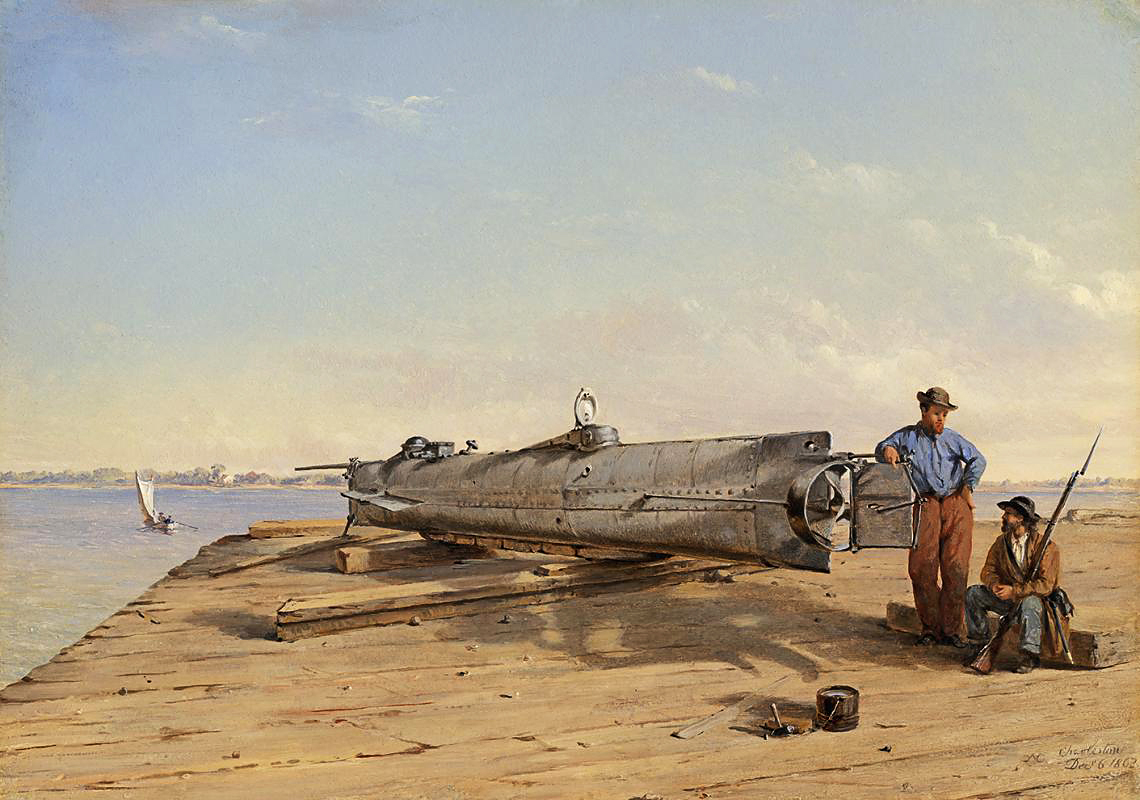The tragic recent news of Titan — the experimental submersible that on June 18, 2023, imploded in the North Atlantic while transporting tourists to the wreck of RMS Titanic — got us thinking about the history of submarines and the courageous pioneers who braved the depths and often died at the controls of both civilian and military submersibles.
There are many claimed “firsts” in the history of the submarine, some of which have been called into question over the decades. But there’s no argument about which was first to sink a warship. The honor goes to the submarine H.L. Hunley, a private sub in support of the Confederate States of America, though its namesake inventor didn’t live to see the fruition of his hard work.
At the outbreak of the American Civil War Tennessee-born Horace Lawson Hunley (depicted standing by his submarine in the above 1864 oil on panel by Conrad Wise Chapman) was practicing as an attorney in New Orleans. Responding to bounties put up by the Confederate government to anyone who sank a Union warship, Hunley teamed with engineers James McClintock and Baxter Watson to develop two prototype submarines, both of which proved failures. By 1863 Hunley had secured funding toward construction of a third sub, named Hunley in honor of its champion.
Slightly under 40 feet in length and 4 feet in diameter, Hunley was powered by a hand-cranked propeller. Seated inside its claustrophobic hull, seven crewmen muscled the propeller shaft while an eighth man steered. Its armament comprised a spar torpedo — a copper cylinder filled with 135 pounds of black powder — mounted to a 22-foot rod extending from the sub’s bow. After ramming the spar into the hull of an enemy ship, Hunley would back away, triggering the charge with an attached line.
Built in Mobile, Alabama, and launched in July 1863, Hunley was shipped by rail later that year to Charleston, S.C., whose outer harbor was under Union blockade. While traveling on the surface with open hatches on Aug. 29, 1863, Hunley was swamped by the wake of a passing ship, and five of its eight-man crew drowned. On a subsequent test run that October 15 Hunley again foundered, this time killing all eight of its crewmen, including its namesake inventor. In the wake of that accident, after Hunley was raised and returned to service, a dubious submariner reportedly scrawled the word COFFIN on its hull. It was a prescient warning.
On Feb. 17, 1864, on its first and only combat mission, Hunley rammed the Union sloop-of-war Housatonic with its spar torpedo and then reversed course. The torpedo detonated, sinking Housatonic with the loss of two officers and three crewmen. But Hunley vanished.
Not until 1995 was the wreck of the groundbreaking submarine located. Raised in 2000, Hunley [hunley.org] today is the centerpiece of the Warren Lasch Conservation Center in North Charleston. Visitors can stroll by a 75,000-gallon tank of fresh water at the bottom of which Hunley rests upright awaiting conservation. In the surrounding museum are artifacts recovered from the wreck.
Subsequent research suggests the crew was likely killed instantly when the torpedo triggered before they were able to back Hunley away from Housatonic. In 2004, in a fitting coda, the crewmen were buried with full military honors at Charleston’s Magnolia Cemetery. In a nearby grave rests the body of Horace L. Hunley.
historynet magazines
Our 9 best-selling history titles feature in-depth storytelling and iconic imagery to engage and inform on the people, the wars, and the events that shaped America and the world.


